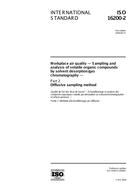We need your consent to use the individual data so that you can see information about your interests, among other things. Click "OK" to give your consent.

ISO 16200-2:2000
Workplace air quality — Sampling and analysis of volatile organic compounds by solvent desorption/gas chromatography — Part 2: Diffusive sampling method
Automatically translated name:
Workplace air quality -- Sampling and analysis of volatile organic compounds by solvent desorption/gas chromatography -- Part 2: Diffusive sampling method
STANDARD published on 8.6.2000
The information about the standard:
Designation standards: ISO 16200-2:2000
Publication date standards: 8.6.2000
SKU: NS-426946
The number of pages: 32
Approximate weight : 96 g (0.21 lbs)
Country: International technical standard
Category: Technical standards ISO
The category - similar standards:
Annotation of standard text ISO 16200-2:2000 :
Description / Abstract: This part of ISO 16200 gives general guidance for the sampling and analysis of volatile organic compounds (VOCs) in air. This part of ISO 16200 is applicable to a wide range of VOCs, including hydrocarbons, halogenated hydrocarbons, esters, glycol ethers, ketones and alcohols. A number of devices and sorbents are recommended for the sampling of these VOCs, each sorbent having a different range of applicability. NOTE Activated coconut shell charcoal is frequently used. Very polar compounds may require derivatization; very low boiling compounds will only be partially retained by the sorbents and can only be estimated qualitatively. Semi-volatile compounds will be fully retained by the sorbents, but may only be partially recovered. This part of ISO 16200 is valid for the measurement of airborne vapours of VOCs in a concentration range of approximately 1 mg/m3 to 1000 mg/m3 individual organic for an exposure time of 8 h. The upper limit of the useful range is set by the sorptive capacity of the sorbent used and, subject to dilution of the analysed solution, by the linear dynamic range of the gas chromatograph column and detector or by the sample splitting capability of the analytical instrumentation used. The lower limit of the useful range depends on the noise level of the detector and on blank levels of analyte and/or interfering artefacts on the sampling devices or in the desorption solvent. Artefacts are typically sub-nanogram for activated charcoal, but higher levels of aromatic hydrocarbons have been noted in some batches.


 Cookies
Cookies
